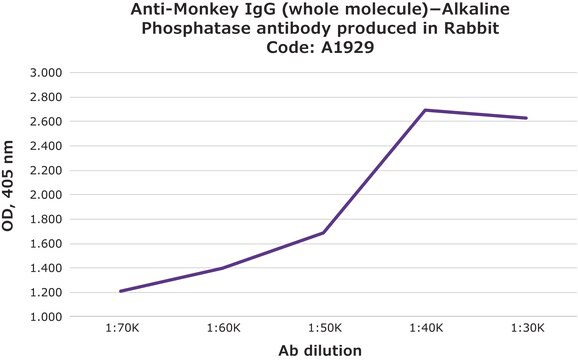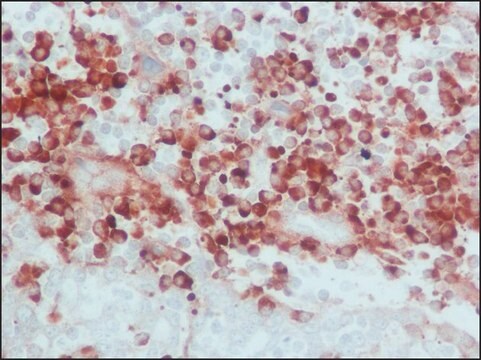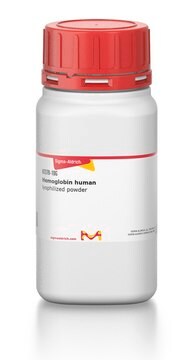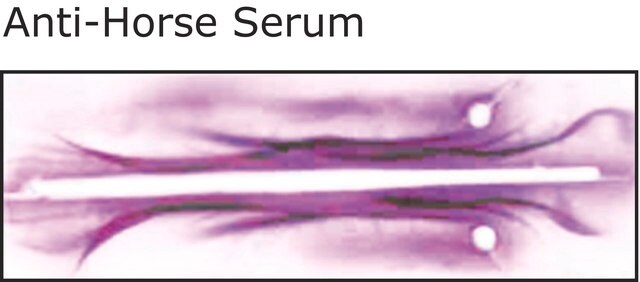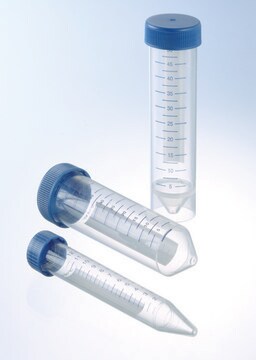A2054
Anti-Monkey IgG (whole molecule)−Peroxidase antibody produced in rabbit
affinity isolated antibody, buffered aqueous solution
Synonym(s):
Rabbit Anti-Monkey IgG (whole molecule)-HRP
Sign Into View Organizational & Contract Pricing
All Photos(1)
About This Item
Recommended Products
biological source
rabbit
conjugate
peroxidase conjugate
antibody form
affinity isolated antibody
antibody product type
secondary antibodies
clone
polyclonal
form
buffered aqueous solution
species reactivity
monkey
technique(s)
direct ELISA: 1:45,000
dot blot: 1:160,000 (direct chemiluminescence assay)
shipped in
dry ice
storage temp.
−20°C
target post-translational modification
unmodified
General description
Immunoglobulins (Igs) have two heavy (H) and two light (L) chains, held together by disulphide linkages. They belong to the immunoglobulin super-family. The heavy chain has one variable N-terminal region and three to four constant (CH1-CH4) C-terminal regions. The light chain has one variable and constant region. IgGs are subclassified into IgG1, IgG2, IgG3 and IgG4.
Monkey IgG is a plasma B cell derived antibody isotype defined by its heavy chain. IgG is the most abundant antibody isotype found in monkey serum. IgG crosses the placental barrier, is a complement activator and binds to the Fc-receptors on phagocytic cells. The level of IgG may vary with the status of disease or infection.
Horseradish Peroxidase (HRP) is an enzyme that catalyzes the conversion of chromogenic substrates such as o-phenylenediamine (OPD), 4-chloro-1-naphthol 3,3′,5,5′-tetramethylbenzidine (TMB), 3,3′-Diaminobenzidine (DAB) or 2,2′-azino-bis(3-ethylbenzothiazoline-6-sulphonic acid) (ABTS); chemiluminescent substrates such as CPS-3 (enhanced luminal) and fluorogenic substrates such as Ampliflu™ Red into detectable chromophores, light-emitters or fluorescers, respectively.
Horseradish Peroxidase (HRP) is an enzyme that catalyzes the conversion of chromogenic substrates such as o-phenylenediamine (OPD), 4-chloro-1-naphthol 3,3′,5,5′-tetramethylbenzidine (TMB), 3,3′-Diaminobenzidine (DAB) or 2,2′-azino-bis(3-ethylbenzothiazoline-6-sulphonic acid) (ABTS); chemiluminescent substrates such as CPS-3 (enhanced luminal) and fluorogenic substrates such as Ampliflu™ Red into detectable chromophores, light-emitters or fluorescers, respectively.
Rabbit polyclonal anti-Monkey IgG (whole molecule)−Peroxidase antibody recognizes monkey IgG in vitro and in monkey serum and biological fluids.
Immunogen
monkey IgG (rhesus)
Application
Anti-Monkey IgG (whole molecule)−Peroxidase antibody produced in rabbit has been used in ELISA of serum samples.
Rabbit polyclonal anti-Monkey IgG (whole molecule)−Peroxidase antibody may be used to detect and quantitate the level of IgG in monkey serum and biological fluids via chromogenic, chemoluminescent or fluorogenic immunochemical or immunohistochemical techniques. It may also be used as a secondary antibody in assays that use monkey IgG as the primary antibody. It may be use to detect parasite-specific antibodies in monkey sera, ELISA assays were performed using HRP-conjugated rabbit anti-monkey IgG as the secondary.
Biochem/physiol Actions
Digestion of IgG by papain results in generation of fragment antigen binding (Fab). Pepsin digestion of IgG results in fragment crystallizable (Fc). Fc regions of IgG antibody have enormous therapeutic potential and are exploited for the development of therapeutic antibodies. IgG1 class is the most abundant and its deficiency results in hypogammaglobulinemia. IgG2 deficiency increases susceptibility to bacterial infections. IgG3 mediates effector functions and IgG4 is associated with asymptomatic infection. The IgG levels in monkey show age related increase. In monkeys, IgG subtypes comprises the predominant antibodies during immune response after hepatitis B surface antigen (HBsAg) vaccination. The human and monkey IgG sequences show divergence only in the hinge region and hence exploited for therapeutic antibody testing.
Physical form
Solution in 0.01 M phosphate buffered saline, pH 7.4, containing 0.05% MIT.
Preparation Note
Prepared by the two-step glutaraldehyde method described by Avrameas, S., et al., Scand. J. Immunol., 8, Suppl. 7, 7 (1978).
Legal Information
Ampliflu is a trademark of Sigma-Aldrich Co. LLC
Disclaimer
Unless otherwise stated in our catalog or other company documentation accompanying the product(s), our products are intended for research use only and are not to be used for any other purpose, which includes but is not limited to, unauthorized commercial uses, in vitro diagnostic uses, ex vivo or in vivo therapeutic uses or any type of consumption or application to humans or animals.
Not finding the right product?
Try our Product Selector Tool.
signalword
Warning
hcodes
Hazard Classifications
Skin Sens. 1
Storage Class
12 - Non Combustible Liquids
wgk_germany
WGK 2
flash_point_f
Not applicable
flash_point_c
Not applicable
Choose from one of the most recent versions:
Already Own This Product?
Find documentation for the products that you have recently purchased in the Document Library.
Customers Also Viewed
Molecular and functional characterization of cynomolgus monkey IgG subclasses
Jacobsen FW, et al.
Journal of Immunology, 186(1), 341-349 (2011)
Katja Peplinski et al.
Microbiology (Reading, England), 156(Pt 7), 2136-2152 (2010-04-17)
Ralstonia eutropha H16 is probably the best-studied 'Knallgas' bacterium and producer of poly(3-hydroxybutyrate) (PHB). Genome-wide transcriptome analyses were employed to detect genes that are differentially transcribed during PHB biosynthesis. For this purpose, four transcriptomes from different growth phases of the
Analysis of immunoglobulin, complements and CRP levels in serum of captive northern pig-tailed macaques (Macaca leonina)
Zhang XL, et al.
Dong wu Xue Yan Jiu = Zoological Research / "Dong wu Xue Yan Jiu" Bian ji Wei Yuan Hui Bian ji, 35(3), 196-196 (2014)
Renato Porrozzi et al.
The American journal of tropical medicine and hygiene, 71(3), 297-305 (2004-09-24)
This study evaluates cross-immunity in rhesus monkeys (Macaca mulatta) previously infected with one species of Leishmania and have had self-cured disease or were cured by antimony-based therapy upon development of full-blown disease. We found that a self-healing cutaneous leishmaniasis (CL)
Development of humanized monoclonal antibody by logical approach: characterization, functional studies in vitro and immunogenicity studies in vivo in non-human primates
Cheah SH, et al.
Scientific Research and Essays, 7(26), 2288-2299 (2012)
Our team of scientists has experience in all areas of research including Life Science, Material Science, Chemical Synthesis, Chromatography, Analytical and many others.
Contact Technical Service